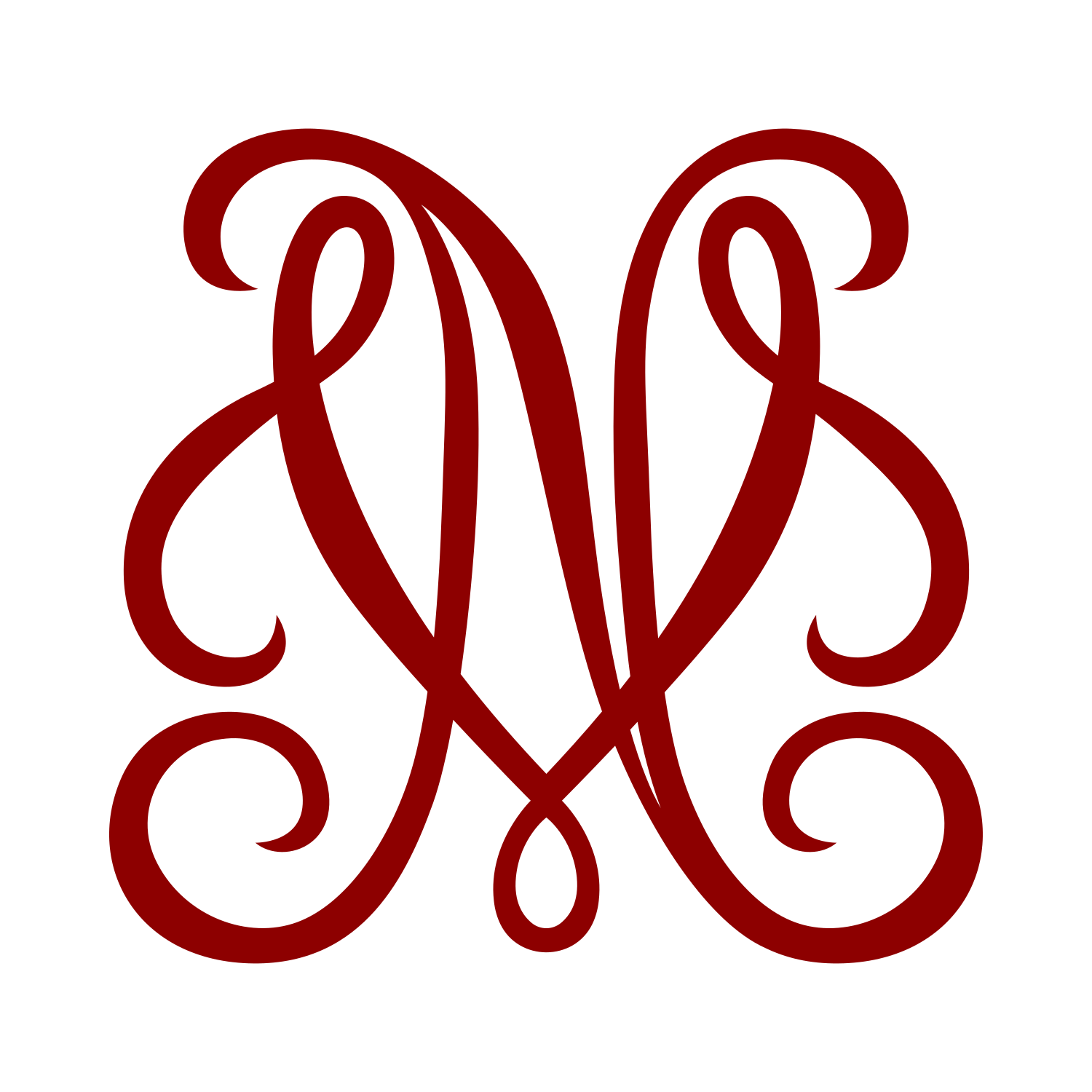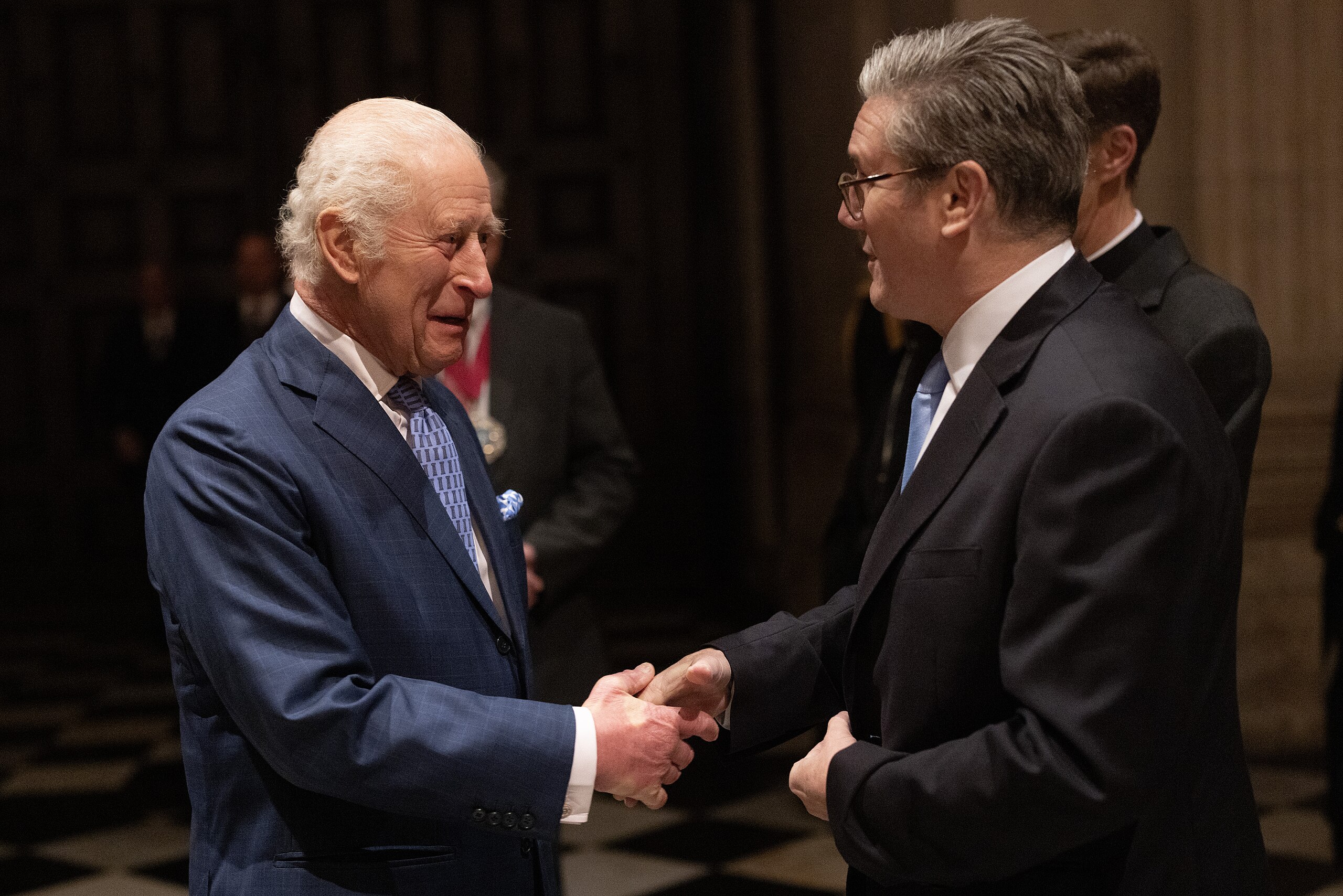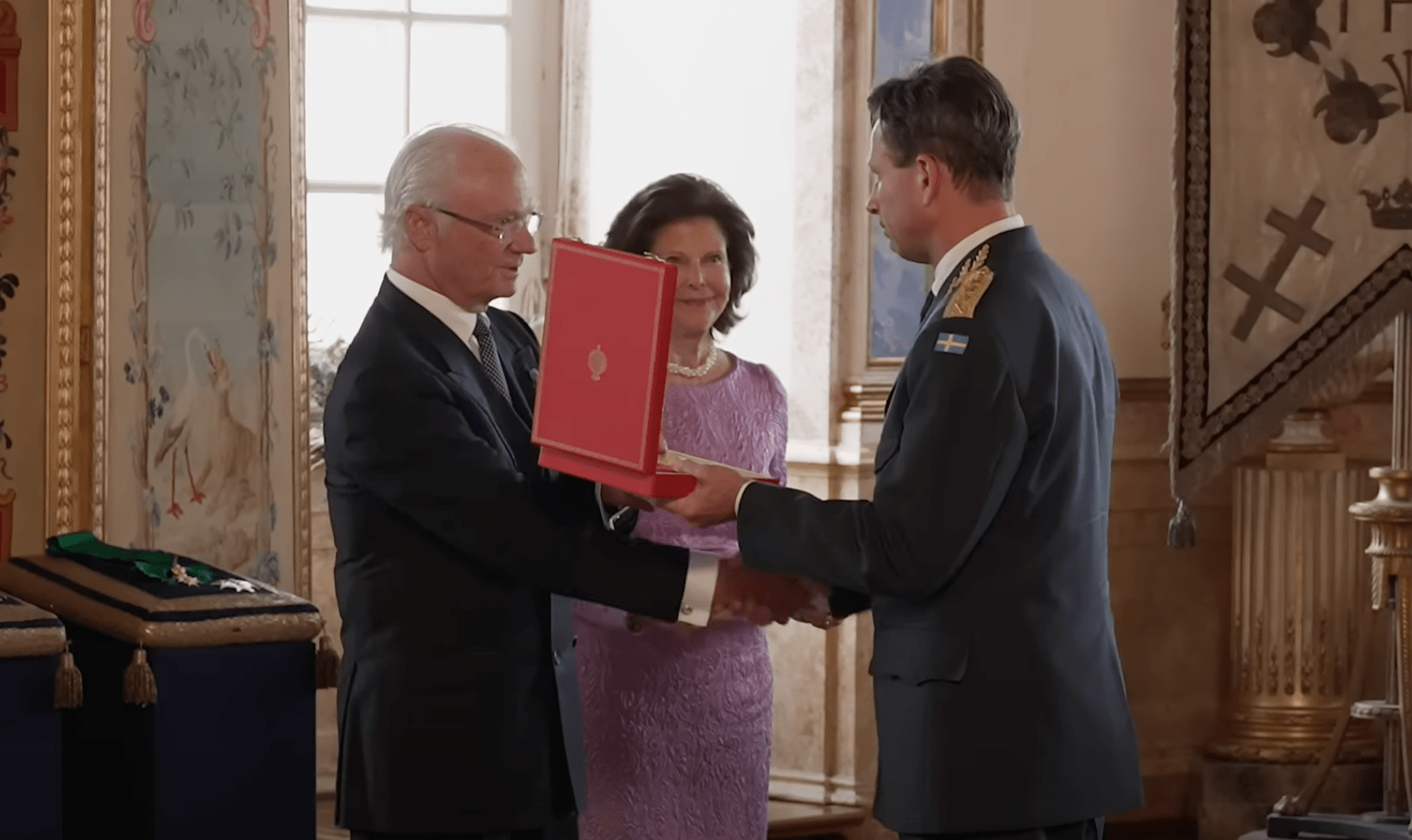The Order of the Seraphim is Sweden’s foremost order of chivalry and is conferred upon members of the Swedish Royal House, foreign heads of state or individuals of equal merits. Each new knight is granted a unique coat of arms, which is traditionally painted on a copper plate. It is now just a matter of time before Finnish president Alexander Stubb will unveil his own coat of arms.

On April 23–24, 2024, the President of the Republic of Finland, Alexander Stubb, paid a state visit to Sweden at the invitation of His Majesty the King Carl XVI Gustaf. The President was accompanied by his wife, Suzanne Innes-Stubb, ministers from the Finnish government, and a business delegation. On the occasion of the state visit, His Majesty the King appointed President Alexander Stubb a Knight of the Order of the Seraphim. Mrs. Innes-Stubb was simultaneously awarded the Grand Cross of the Order of the Polar Star.
In my bachelor thesis in art history, I explored both the Icelandic and Finnish presidents’ Order of the Seraphim coat of arms. In anticipation of Stubbs’ arms, here is a summary of all former Finnish presidents’ coat of arms (Svinhufvud and Mannerheim excluded, as they – as noblemen – use their own coat of arms, while presidents Ståhlberg and Ryti did not receive the Order of the Seraphim):

Lauri Kristian Relander
Lauri Kristian Relander was Finland’s second president, serving from 1925 to 1931. Relander was born on May 31, 1883, in Kronborg and died on February 9, 1942, in Helsinki. He was appointed a Knight of the Order of the Seraphim at Stockholm Palace on August 19, 1925. His motto is “Patriae servio” (English: I serve the homeland). The copper plate was painted in 1930 by David Friefeldt and the coat of arms was designed by Jorma Gallen-Kallela.
The arms consist of three golden ears of grain on a black background. More specifically, the grain depicted is rye, identifiable by its awns. The rye symbolize Relander’s agrarian background. Following in his father’s footsteps as an agronomist, Relander studied agronomy at the University of Helsinki and earned a doctorate in 1914 with a dissertation on seed germination. He was also a member of the Agrarian League, today known as the Centre Party of Finland.
But why rye? Rye is a highly significant grain for Finns, as reflected in its widespread popularity as an ingredient in Finnish cuisine. For example, rye bread was chosen as the national dish for Finland’s centenary. However, the specific choice of three ears is harder to interpret. The number three holds symbolic meaning in many cultures, often representing diversity or luck. From a heraldic perspective, it is important that the design fills the entire shield, which three ears effectively do.
In addition to rye’s importance for Finland, ears of grain are generally symbols of fertility, renewal of life, and resurrection – of a good harvest, prosperity, and happiness – fitting symbols for a young nation taking its first steps, and equally reflective of Relander’s own work and legacy. This symbolism is also found in his motto. Relander serves – symbolically harrowing, sowing, and plowing – the homeland. It is reminiscent of how Napoleon used ears of wheat – admittedly another grain – as a symbol, for example in a tiara for Empress Josephine, whose symbolic message has been interpreted as “an emblem of prosperity and generosity, evoking rebirth and peace.”
The color choices are likely aesthetic rather than symbolic. The golden color of the ears reflects the natural yellow of rye. Why black was chosen as the background is unclear; perhaps it represents light in darkness. The use of color symbolism is more evident in other parts of the coat of arms. The tinctures of the helmet mantling use the colors of the Finnish flag. In heraldry, it is customary to use the main tinctures of the shield in the mantling, but here Gallen-Kallela has instead used the flag’s colors. Interestingly, the torse reuses the shield’s tinctures instead. Finally, the crest features the presidential pennant of Finland, which combines the country’s and the president’s main symbols – the flag and the national coat of arms.

Kyösti Kallio
Kyösti Kallio was Finland’s fourth president, serving from 1937 to 1940. Kallio was born on April 10, 1873, in Ylivieska and died on December 19, 1940, in Helsinki. He was appointed a Knight of the Order of the Seraphim at Stockholm Palace on June 15, 1938. The copper plate was painted in 1939 by David Friefeldt.
Kallio’s coat of arms is a simple monogram, rendered in a modern typeface and using the colors of the Finnish flag. Kallio never had time to submit a proposal for a coat of arms. Instead, the Swedish artist Brita Grep—frequently commissioned by the State Herald of Sweden in Stockholm—chose the initials as the motif, as monograms had been permitted by the statutes of the Order of the Seraphim since 1902.
Nevertheless, the design is well-suited to its recipient. Kallio was a convinced republican, though moderate and inclined toward compromise. During the heated debate on introducing a monarchy in Finland, Kallio had opposed his own party and its pro-monarchist stance. This ultimately led to Kallio resigning from his post in the Senate in protest. Once he was elected president, Kallio could hardly refuse to accept a foreign royal order. Thus, the simple and unconventional motif may be seen as a subtle reference to his earlier protest. However, it should be emphasized that monograms, as previously noted, are not an anomaly among the coats of arms of the Order of the Seraphim. Nonetheless, strictly speaking, monograms are considered non-heraldic.
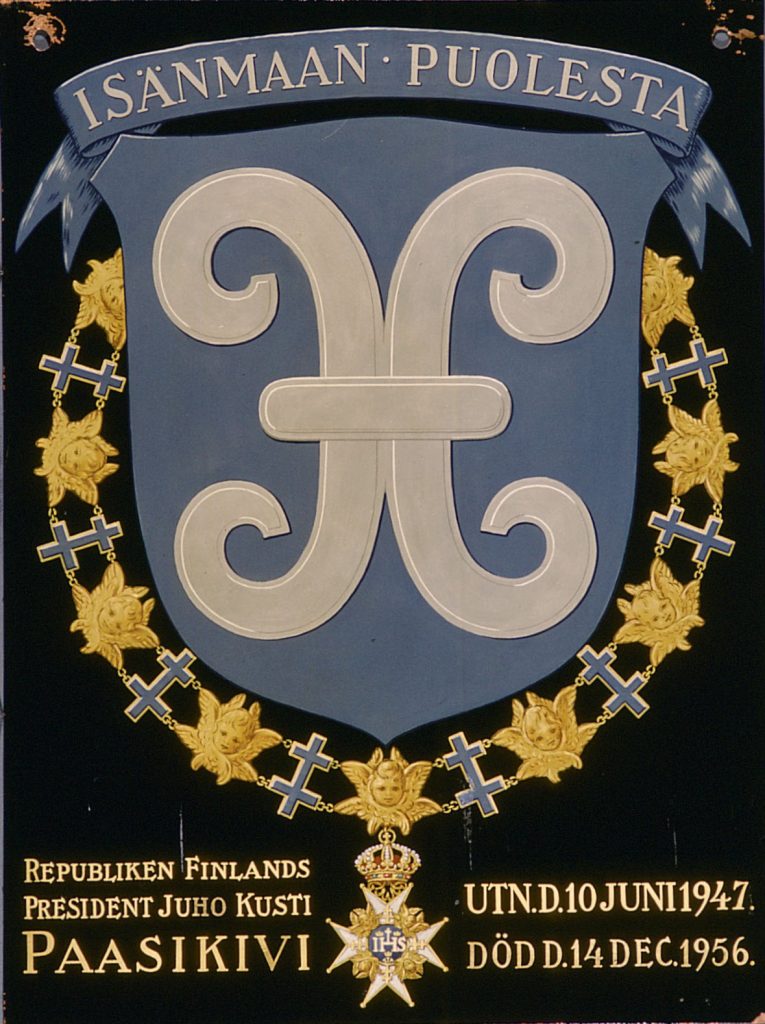
Juho Kusti Paasikivi
Juho Kusti Paasikivi was Finland’s seventh president, serving from 1946 to 1956. Paasikivi was born on November 27 in Koski and died on December 14, 1956, in Helsinki. He was appointed a Knight of the Seraphim at Stockholm Palace on June 10, 1947. His motto is “Isänmaan puolesta” (English: For the Fatherland). The copper plate was painted in 1952 by David Friefeldt and the coat of arms was designed by Gustaf von Numers in 1950.
The shield uses the colors of the Finnish flag and consists of a single, general image: a medieval wall anchor. A wall anchor is a structural element that holds together different parts of a building. In German heraldic tradition, the wall anchor is a fairly common image. They are often used to symbolize cohesion – and that is precisely what the wall anchor in Paasikivi’s coat of arms is explicitly meant to represent.
Cohesion was a recurring challenge in the history of the young republic of Finland – not least the political division that led to the Civil War in 1918, but also the language question and – in Paasikivi’s case in particular – the debate over monarchy versus republic. However, Paasikivi’s legacy is characterized by unity and unification. Throughout his career, Paasikivi consistently sought to negotiate, mediate, and act diplomatically.
The simple motif of the coat of arms affirms Paasikivi’s legacy and political principles as a unifying force acting in the nation’s interest. The motto, which is also the motto of Finland’s Order of the Cross of Liberty, reinforces this further. The simplicity of the composition, and the object itself, also evoke antiquity. Paasikivi was a conservative, and an wall anchor can symbolize this as well – not only as a historical object, but also through its function: to reinforce, anchor, and preserve – concepts that are strongly aligned with conservatism as an ideology.
Paasikivi is, together with his predecessor Kallio (who must nevertheless be considered in a class of his own), the only Finnish head of state to feature a man-made object in his coat of arms. Others in some way refer to nature in their heraldry.

Urho Kekkonen
Urho Kaleva Kekkonen was Finland’s eighth president, serving from 1956 to 1982. Kekkonen was born on September 3, 1900, in Pielavesi and died on August 31, 1986, in Helsinki. He was appointed a Knight of the Order of the Seraphim at Stockholm Palace on October 2, 1956. His motto is “Sitä kuusta kuuleminen” (English: Listen to the sound of that fir tree). The copper plate was painted in 1957 by David Friefeldt and the coat of arms was designed by Gustaf von Numers in 1956.
Kekkonen’s coat of arms consists solely of ordinary charges, with a golden fir-twigged fess on a green background. Kekkonen is also unique among Finnish presidents in that neither the colors of Finland’s flag nor the national coat of arms are used. While Finland’s army colors are indeed green and gold, this is probably purely a coincidence.
The archaically simple – and thus striking – motif is unmistakably Finnish. However, knowledge of the context is required to understand its particular significance for Finland. The specific fir-twig line in Kekkonen’s coat of arms is actually a Finnish heraldic innovation, dating back to 1918. The fir-twig, in independent Finland, acquired a patriotic symbolism. During the Civil War, when the White Army was advancing on Tampere, a symbol was needed to distinguish friends from enemies in the heat of battle. The White troops then placed a fir-twig in their hats, much like the Swedish troops at the Battle of Lund in 1676 used a straw wreath in their hats. After the war, the fir-twig appeared as a motif in various military insignia. In the 1950s, the fir-twig line was introduced into Finnish heraldry by the same Gustaf von Numers mentioned above. The fir-twig in Kekkonen’s coat of arms also represents the motto, which comes from a Finnish proverb: “Listen to the sound of that fir tree, at whose root your home is fastened.” The proverb is found in Zacharias Topelius’s work The Book about Our Land, a book that had a profound influence on Finland’s intellectual history. With this work, Topelius aimed to create a clear Finnish national identity. The proverb appears in the introduction to the book when Topelius describes what the fatherland and the home of the Finnish people are.
For Finns, the sound of the fir tree is a part of the national soul – it represents home and security. In its simplicity, Kekkonen’s coat of arms is a patriotic confession of his love for the fatherland. Kekkonen, in other contexts, tried to shape the image of himself as coming from the deep roots of the people. For example, before his first presidential candidacy in 1949, Kekkonen had the chimney removed from a photograph of his birthplace, the Lepikko cottage, to appear more folk-like. His father was originally a forest worker but had worked his way up to the middle class as a supervisor and timber agent. Kekkonen’s mother was the daughter of a landowner. Thus, it was not strictly speaking a working-class cottage background, even though Kekkonen liked to emphasize his identity as such.
The choice of the fir-twig, the green color of the forest, and the yellow of the grain fields reflects Kekkonen’s own wish for a coat of arms that would connect to Finnish agriculture and forestry. The tinctures are also found in the coat of arms of Kainuu, the region where Kekkonen grew up. Kekkonen’s arms is similar to Kainuu’s, and at least a clear allusion to the president’s arms can be seen, but Kainuu’s regional coat of arms is younger.
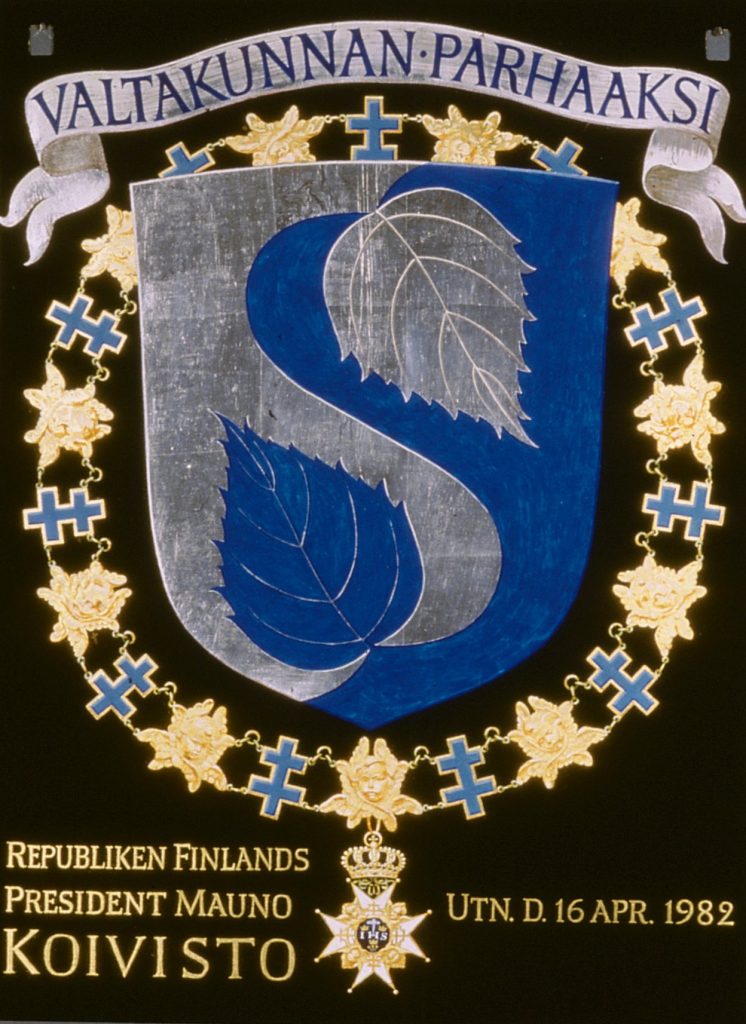
Mauno Koivisto
Mauno Koivisto was Finland’s ninth president from 1982 to 1994. Koivisto was born on November 25, 1923, in Turku, and passed away on May 12, 2017, in Helsinki. He was appointed a Knight of the Order of the Seraphim at Stockholm Palace on April 16, 1982. His motto is “Valtakunnan parhaaksi”(English: For the good of the country). The copper plate was painted in 1991 by Bengt Olof Kälde. Heralds had submitted proposals to Koivisto before the president himself had decided on the question of a coat of arms. Koivisto then based his choice on the proposals submitted by his former teacher, Professor Knut Pipping, in 1982.
The coat of arms is a canting arms, representing the bearer’s name in a visual pun or rebus, and follows the colors of the Finnish flag. Two birch leaves in contrasting tinctures “shoot out” from a wavy line, called an “ess curve.” In Finnish, koivu means birch, and the suffix -sto indicates a place. Thus, Koivisto can be translated as birch grove. The ess curve forms an S, which, according to correspondence between Pipping and the painter of the Danish Order of the Elephant’s arms (which has the same tradition of coat of arms as the Order of the Seraphim), stands for “Suomi” (Finnish for Finland). However, a deeper meaning can be generated, given the intertextuality of the motif. Just like the similar symbol taijitu in Chinese philosophy, which represents opposites—yin and yang—in harmony, Koivisto’s coat of arms seems to evoke similar connotations. Koivisto’s actions were marked by his ability to unite opposites or extremes. For example, in foreign policy, Koivisto, thanks to his contacts with both the USA and the Soviet Union, was able to play a mediating role during the tension between the two superpowers. This is further reinforced by the motto.
The birch also carries its own significance. It is a symbol of fertility and light, and in Nordic culture, it has been sacred to Thor and Frigg. The birch is also Finland’s most common deciduous tree and the national tree of Finland. Therefore, the birch is an important symbol of Finnish identity and culture. It is a natural part of decorations at parties in Finland during spring and summer, such as May and midsummer poles, and birch twigs are often used in Finnish saunas. Zacharias Topelius’s story The Birch and the Star is well known among Finns. In the tale, the birch, together with the star shining through its leaves, forms a landmark that helps the main characters, two children who were taken to Russia during the Great Northern War, find their way home again.
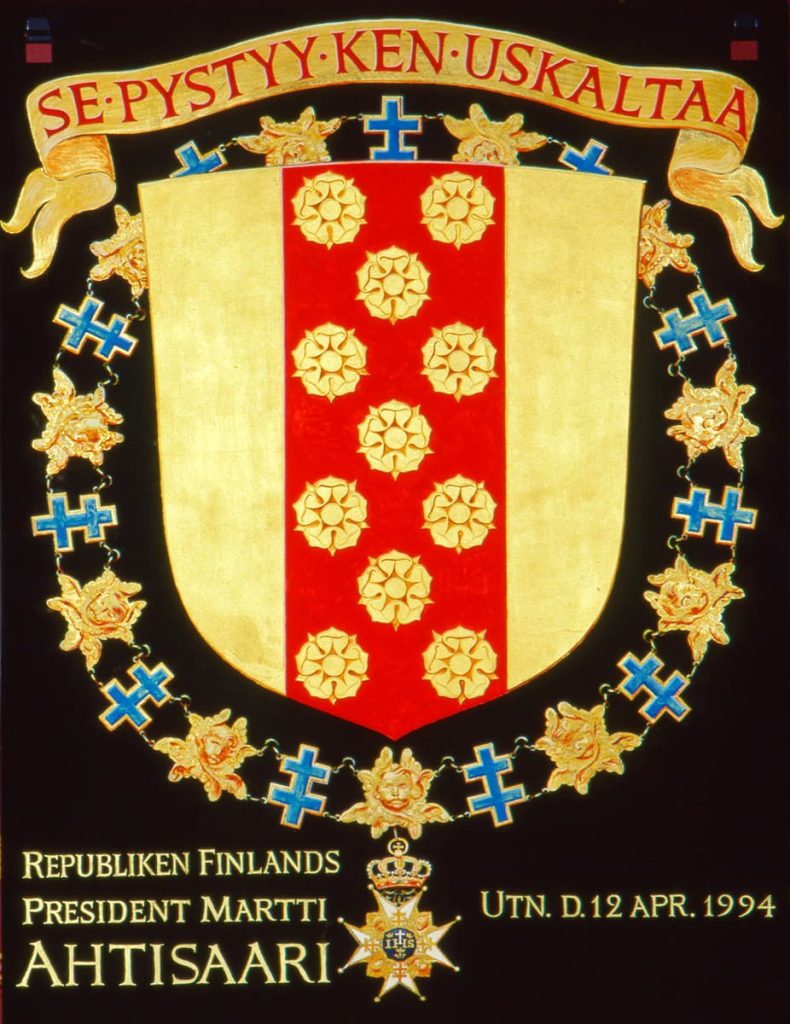
Martti Ahtisaari
Martti Ahtisaari was Finland’s tenth president from 1994 to 2000. Ahtisaari was born on June 23, 1937, in Vyborg and passed away on October 16, 2023, in Helsinki. He was appointed a Knight of the Seraphim at Stockholm Palace on April 12, 1994. His motto is “Se pystyy ken uskaltaa” (English: He who dares, succeeds). The copper plate was painted in 1996 by Bengt Olof Kälde and the arms was designed by Harri Rantanen in 1995.
Ahtisaari’s coat of arms had a somewhat different process than those of previous presidents. The President’s office tasked the National Archives and the State Heraldry Board with providing an opinion on the matter and suggestions for a heraldically correct coat of arms. 57 proposals were received, some of which came from artists on their own initiative. As an advisory body, the board pointed out to the President’s office that the coats of arms of previous presidents not only served as a symbol of the office of president but also represented the personal arms of the president—that is, the coat of arms does not necessarily have to be linked to the office, but should primarily be personal. The decision was then made by the president’s wife, and it was based on Harri Rantanen’s proposal.
The heraldic rose is a common image in heraldry. The rose is always depicted in a highly stylized form, as a wild rose with five petals. The rose is also one of our most beloved flowers and has appeared in many cultures as a symbol of life, beauty, memory, and—above all—love. However, considering the context, it is clear where the motif originates. The roses—along with the tinctures in the shield—refer to the office of the president. The roses and tinctures are found in Finland’s national coat of arms. Finland’s national coat of arms was created during the reign of Swedish king Gustav Vasa, and the significance of the roses is not known.
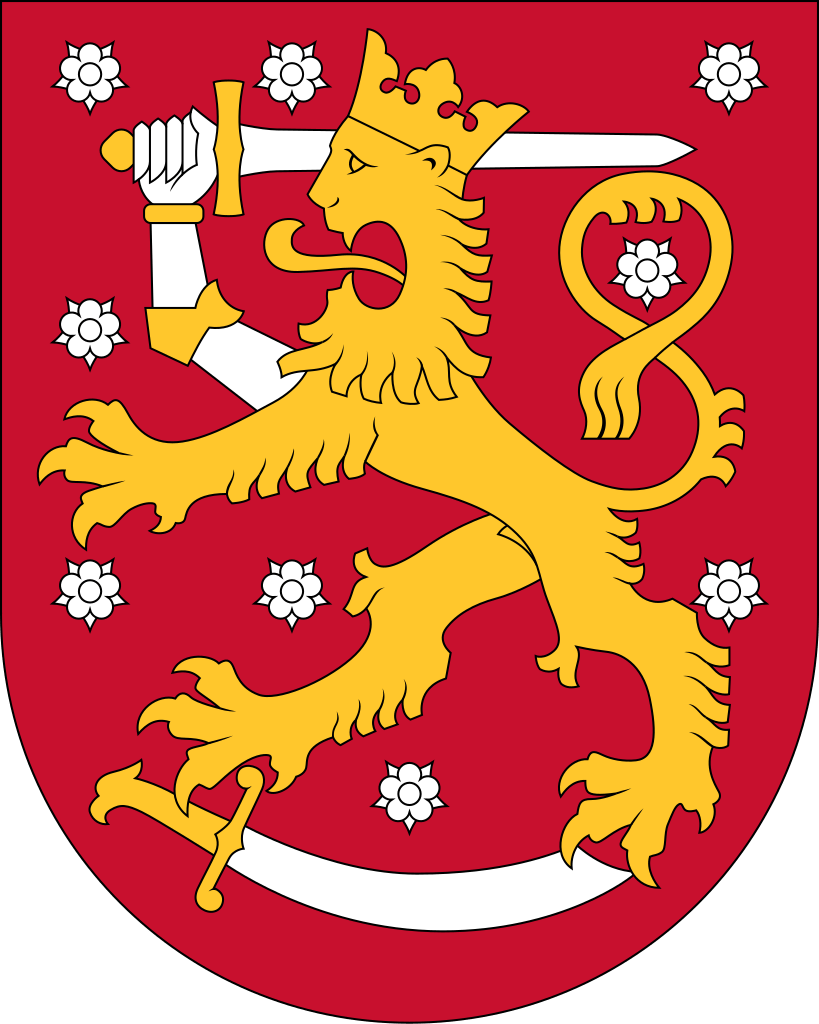
One theory is that the roses represent the historical provinces of Finland, of which there were nine. However, Ahtisaari’s coat of arms is adorned with eleven roses. What the number is intended to represent is not obvious. Heraldic artist Rantanen affirmed in an interview with Helsingin Sanomat that the motif does not carry any particular symbolism, other than referring to the office of the president.
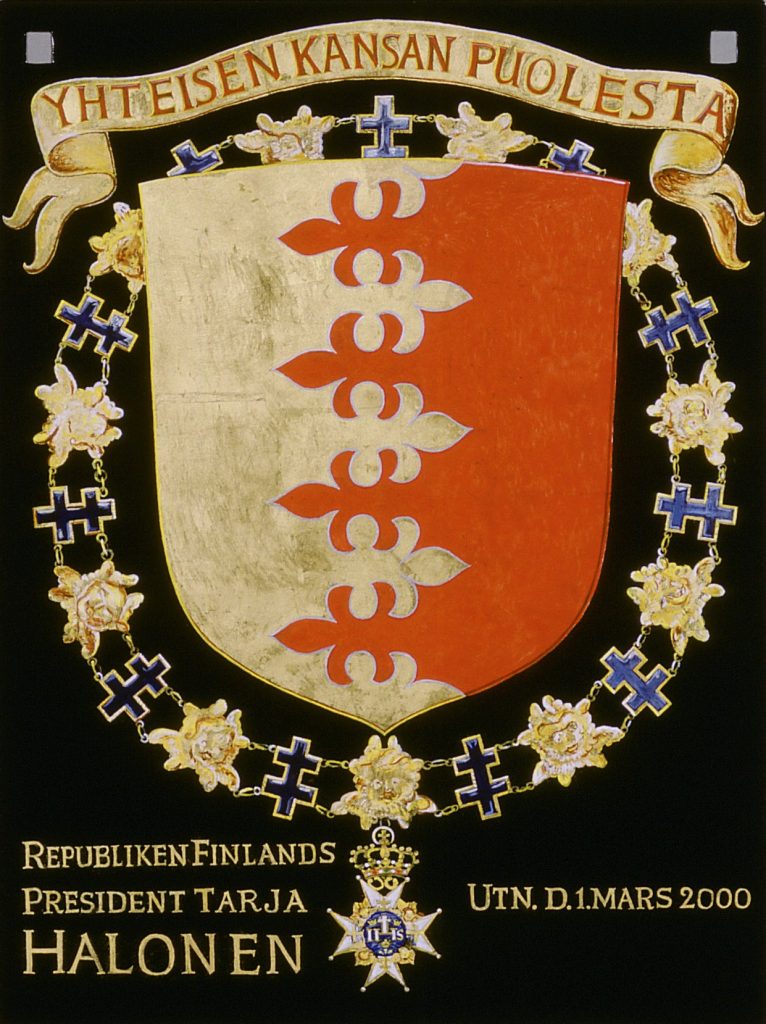
Tarja Halonen
Tarja Halonen was Finland’s eleventh president from 2000 to 2012. Halonen was born on December 24, 1943, in Helsinki. She was appointed a Knight of the Order of the Seraphim at Stockholm Palace on April 10, 2000. Her motto is “Yhteisen kansan puolesta” (English: For a united people). The copper plate was originally painted in 2003 by Bengt-Olof Kälde and later repainted in 2021 by Leif Ericsson. The coat of arms was designed by Harri Rantanen in 2002.
Halonen’s coat of arms also features the colors of the Finnish national coat of arms. The charge that divides the shield is a so-called lilyous partition. The coat of arms can somewhat be considered a canting coat of arms, as the lilies divide – in Finnish, halkoinen – the shield.
The lily is a symbol of power and refers to the president’s leading position and strength. When the coat of arms was presented, it received criticism from the heraldic expert Leif Tengström, who questioned the choice of the lily as a symbol, reasoning that it would be a reference to the Virgin Mary. However, many people throughout history, both men and women, have used lilies in their coats of arms. For example, Sweden’s Queen Silvia has a lily divided in red and gold in her seraphim coat of arms. The heraldic lily, also known as the fleur-de-lis, is, alongside the rose, the most common flower in heraldry.
Since antiquity, the lily has been a symbol of purity and was adopted by the Roman Catholic Church as a symbol of the Virgin Mary. In addition to the Christian interpretation, the lily is most known as a symbol of power, primarily for the sovereignty of the French monarchy. Legend has it that an angel gave King Clovis of the Franks (466–511) a lily during his baptism as a sign of his purification. When Pope Leo III crowned King Charlemagne of the Franks as emperor in 800, the pope is said to have given the emperor a blue banner adorned with golden lilies, which became the origin of the French national flag.
In Halonen’s context, the association is not with the Virgin Mary, but rather with power. The motif also carries a unifying symbolism. The dividing charge does not split, but unites and intertwines a pair of opposites in the form of the shield’s two divided parts. This significance and symbolism have been noted in previous coats of arms, including Koivisto’s, and as heraldic expert Rantanen has confirmed in a previous interview, the lily represents the president’s power.
Solidarity and tolerance, integration and equality were some of Halonen’s key political issues, all of which are about uniting the people. This significance is reinforced by Halonen’s motto, which she also used in a modified form as a slogan during her second presidential election campaign: “The President of All the People”.
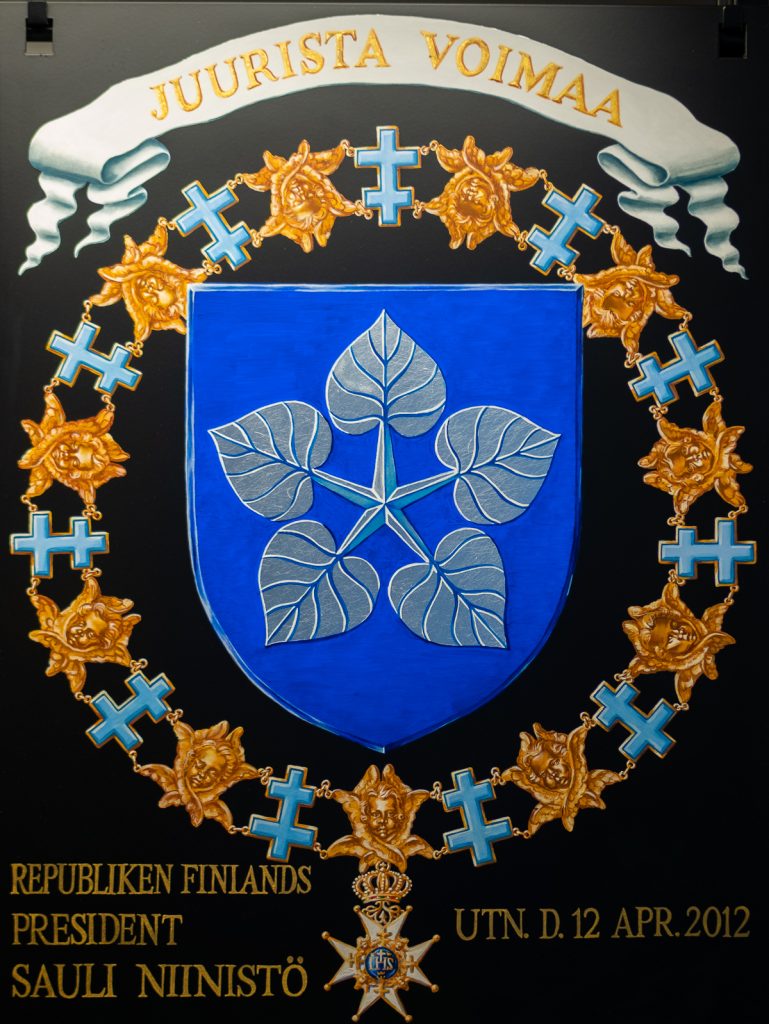
Sauli Niinistö
Sauli Niinistö was Finland’s twelfth president from 2012 to 2024. Niinistö was born on August 24, 1948, in Salo. He was appointed a Knight of the Order of the Seraphim at Stockholm Palace on April 17, 2012. His motto is “Juurista voimaa”(Swedish: Kraft ur rötterna – Strength from the roots). The copper plate was painted by Leif Ericsson in 2016 and the coat of arms was designed by Antti Matikkala and Ronny Andersen in 2012.
Niinistö’s coat of arms is a canting arms in the colors of Finland’s flag. The Finnish word niini is a short form of niinipuu, which means linden tree. Niinistö can thus be roughly translated to linden grove. The Niinistö family name was, before fennicisation, Lindström. Lindens and linden leaves are often found in heraldry, particularly in the German tradition, which is closely related to the Nordic tradition.
The symbolic value of the linden is generally significant and carries positive connotations in several cultures. In the Nordic countries, the linden has been associated with the fertility goddess Freja. In European culture, particularly in the Germanic tradition, the linden has played a more prominent role. Before the Christian era, the linden was regarded as a sacred tree and symbolized marital love. It was customary for two lovers to swear eternal love under a linden tree, as it was believed that under the linden, one always spoke the truth. Linden also frequently appears in Germanic literary traditions. The poem Under the Linden by the German poet Walther von der Vogelweide is an example of this. The linden, more specifically a linden leaf, also plays a significant role in the German epic Nibelungenlied.
The linden also symbolized justice. People would gather under a linden tree to dispense justice and make peace. The linden continued to be associated with justice even after the arrival of Christianity, and in some places, judgments were made under a linden tree until the Enlightenment period. Aside from its symbolic significance for Niinistö, the linden is also a fitting symbol to represent the president’s former career as a lawyer. The motto also functions as a wordplay since juurista – meaning from the roots in Finnish – is very similar to juristi, which means lawyer. The five linden leaves in the coat of arms are arranged in a way that references the heraldic rose, and thus, also symbolizes the Order of the White Rose of Finland and its star.
